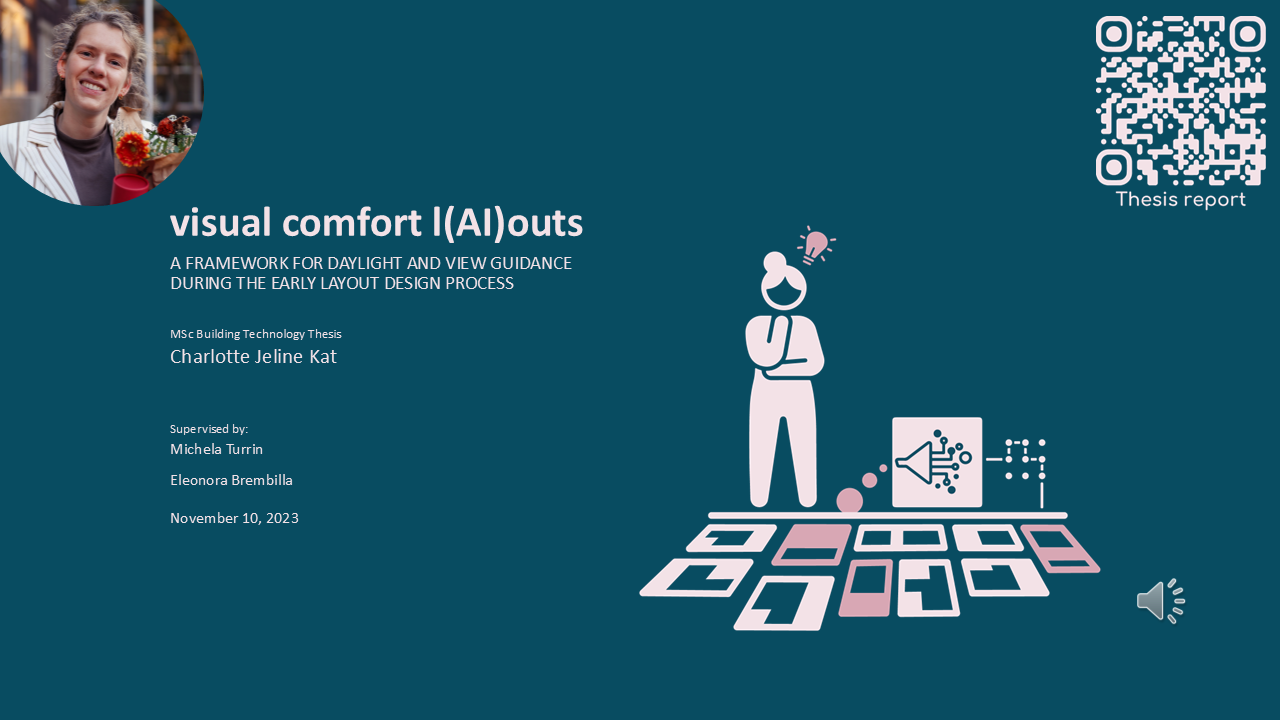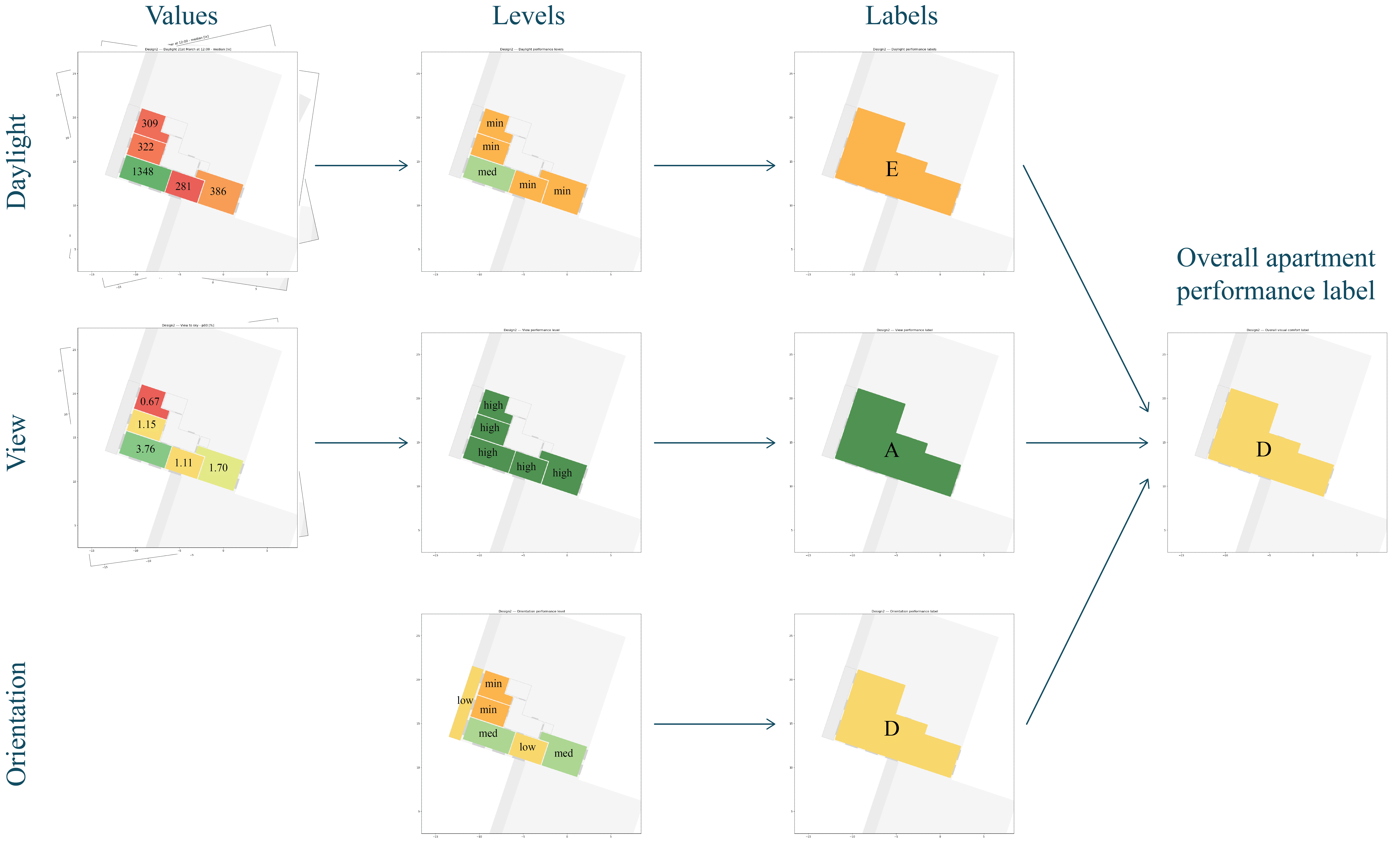Thesis: Multi-Modal Supervised Daylight and View Prediction on Layouts—Kat
-
Intro
-
Technical Aspects
Information
| Primary software used | Python |
| Software version | 1.0 |
| Course | Thesis: Multi-Modal Supervised Daylight and View Prediction on Layouts—Kat |
| Primary subject | AI & ML |
| Secondary subject | Machine Learning |
| Last updated | November 3, 2025 |
| Keywords |
Responsible
| Teachers | |
| Faculty |
Thesis: Multi-Modal Supervised Daylight and View Prediction on Layouts—Kat 0/1
Thesis: Multi-Modal Supervised Daylight and View Prediction on Layouts—Kat
A framework for daylight and view guidance during the early layout design process
Project Overview
Optimizing the layout of residential buildings based on daylight performance and view quality is crucial to visual comfort and well-being of building occupants. Machine Learning (ML) methods offer valuable support for performance-based decision-making process at the early-stage building design.
In this study, a novel workflow is introduced to integrate ML models into the architectural design process. With the designer’s input floor layout designs, the presented multimodal ML model predicts daylight provision and view quality, which are then translated into practical visual representations by a post-processing step. This approach allows input designs to be evaluated by the ML model, leading to enhanced design decisions while preserving the designer’s autonomy.
Results for the best-performing model, implementing ResNet50 and a fully connected network, led to a Mean Square Error (MSE) of 0.0440 and 0.0478, and an R2 score of 0.7411 and 0.7815 for the daylight and view metrics, respectively. The results of the daylight and view predictive models are further interpreted according to different apartment categories and at various resolutions.
These results indicate that the method could be viable for predicting daylight provision and view quality in early design tools, providing designers with faster feedback that supports informed decision-making during design iterations. Ultimately, the challenges of the study and further improvements are discussed.

AWARD: Dutch Daylight Student Award 2024, Research
PUBLICATION: Journal Paper – International Journal of Architectural Computing
Project Information
- Title: visual comfort l(AI)outs: A framework for daylight and view guidance during the early layout design process
- Author(s): Lotte Kat
- Year: 2023
- Link: https://resolver.tudelft.nl/uuid:50cc1638-d7ff-4d48-8342-73f4a7cfb882
- Type: Master Thesis, Building Technology
- ML Tags: ResNet50, fully connected network, supervised learning
- Topic Tags: Layout Design, Design Workflow
Thesis: Multi-Modal Supervised Daylight and View Prediction on Layouts—Kat 1/1
Technical Aspectslink copied
This study proposes a novel workflow that integrates Machine Learning (ML) models into the architectural design evaluation process, guiding designers in their assessment of performance indicators. This workflow enables well-informed decisions to be made that improve the quality and performance of residential layouts while adhering to contemporary design standards and requirements.
Design Workflow
The proposed ML design process framework consists of two layers:
- a designer layer, where designers provide design options and receive direct feedback, and
- a hidden ML process layer, where data processing and prediction occur
In the hidden layer, uploaded layout options are pre-processed into individual room images and combined numerical data. Based on this input, an ML model makes room-wise predictions for daylight performance and view quality. These predictions are then post-processed to generate visual overlays and quantitative performance scores that link the results for each room to the complete layout. During this stage, a layout evaluation system quantifies the overall performance of each design alternative. A ranking system then highlights the best-performing layouts according to selected criteria, such as daylight, view quality or room orientation.
Using the visualised predictions and the optimiser’s ranking, designers can evaluate alternative layouts, focusing on specific performance criteria such as daylight, view quality or room orientation. This iterative process combines human intuition with data-driven assessment, enabling designers to make informed, performance-based design decisions.

A custom evaluation system has been developed to assess the suitability of residential layouts in terms of daylight, views and room orientation. Focusing on key living spaces, the system uses EN 17037 standards to provide consistent performance labelling. It combines these metrics to produce a single apartment score, which can be adjusted according to the importance of each factor and penalises poorly performing rooms. This helps designers to compare and prioritise layouts. Post-processing converts machine learning model predictions into measurable performance levels and visual feedback, enabling flexible, data-driven design decisions.

ML Framework
A multimodal Machine Learning (ML) model was developed and trained on the Swiss Dwellings dataset to predict daylight and view performance in residential layouts. The model was designed to process three inputs—one room image and two numerical features—and to generate five continuous performance outputs: three daylight values (for March, July, and December) and two view metrics (view to sky and view to ground).
The final network architecture combines image-based and numerical data streams through a hybrid fusion approach. Image features are first extracted using a ResNet50 network, which captures spatial and contextual information from room images.

The model was fine-tuned through experiments, adjusting the fusion strategy, architectural layers, and regularization settings to optimize predictive accuracy. To improve stability, the final framework was divided into two specialized sub-models, one dedicated to daylight and the other to view metrics. The best-performing model, implementing ResNet50 and fully connected layers, achieved an MSE of 0.0440 and 0.0478, and an R² score of 0.7411 and 0.7815 for the daylight and view metrics, respectively. These results confirm the model’s capability to generate accurate and continuous performance predictions. Overall, the fine-tuned multimodal framework showed robust predictive capability and high adaptability for early-stage design evaluation. By effectively combining visual and numerical data, it provides reliable performance estimations that support informed, data-driven design decisions.

Write your feedback.
Write your feedback on "Thesis: Multi-Modal Supervised Daylight and View Prediction on Layouts—Kat"".
If you're providing a specific feedback to a part of the chapter, mention which part (text, image, or video) that you have specific feedback for."Thank your for your feedback.
Your feedback has been submitted successfully and is now awaiting review. We appreciate your input and will ensure it aligns with our guidelines before it’s published.
